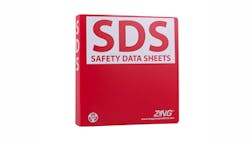Stop-painting.com published an article written by MESH risk management consultant Chris Palmisano that demystifies the process of labeling secondary chemical containers while still complying with OSHA's new GHS rules. This article focuses on educating employers and Safety Managers on the challenges associated with the new Global Harmonization System or (GHS) for classifying chemicals and provides simple solutions for compliance.
OSHA announced that in 2013 Hazcom (Hazard Communication) 1910.1200 violations were the second most frequently cited standard of the top 10 violations in workplace compliance inspections.* OSHA publishes their Top 10 list annually to inform employers about commonly cited standards, so they can take steps to comply, identify hazards, protect employees and ultimately avoid citations.
Besides training employees on the new GHS (Global Harmonization System) labeling elements, new pictograms, and the new SDS (Safety Data Sheet) format, there are more important challenges to compliance such as workplace labeling that many employers and Safety Managers may not even realize.
OSHA officially changed the name of the MSDS to SDS. As a former OSHA compliance officer, Chris explains in the article an easy way to avoid a citation. "Today, if a Compliance Officer sees your old MSDS book proudly displayed in the workplace, they know to ask questions about your Hazcom/GHS training programs. Chances are that you are likely a good candidate for Hazcom/GHS citations. However if they see an “SDS” book displayed in your workplace, they immediately know that you are likely up to speed on the new GHS regulations. So a single name change and changing your cover on your old MSDS book to SDS could help in avoiding Hazcom citations."
OSHA has stated that employers can use any system they wish for workplace labeling as long as it conveys the hazards of the chemical. Employers must understand that GHS is a Globally Harmonized System for classifying chemicals internationally for trade. The unfortunate truth is that other countries do not use the United States' HMIS system and HMIS ratings for chemicals are not a requirement in any of the 16 sections of the SDS. Employers need to actually consider discarding the old HMIS rating codes and come with a workplace labeling system that is concurrent with GHS label elements. OSHA says that you have until June 1st 2016 to develop a workplace labeling system.
A more appropriate workplace label would convey the elements of the GHS labeled parent container, as shown below. Holding on to an antiquated HMIS system is a recipe for potential disaster and certain to be a great way to get someone hurt or receive an OSHA Hazcom citation. Employees will rather not label a secondary container than try to figure out the appropriate hazard class numbers.
Stop-painting.com's GHS Secondary Labels are much more efficient and safer way to label secondary workplace containers. Employees need only look at the elements of the GHS labeled parent container and they have enough information to properly label the workplace container.
The author, Chris Palmisano, is a certified Manager of Environment Safety & Health. Chris’s current career in Risk Management Consulting spans over 35 years. Chris was a former Homeland Security Consultant for the US Department of Justice and Department of Defense. He served as a Fire Lieutenant in the Philadelphia Fire Department’s Hazmat Administration Unit, Sergeant in the US Air Force, Safety Consultant for the State of NC, and as a Compliance Officer for OSHA. Since 2005 has been working as a Risk Management Consultant. Chris graduated from North Carolina State University’s MESH Certification Program, where he obtained certification as a Manager of Environmental Safety and Health.
*United States Dept. of Labor Website: Osha.gov/Top_Ten_Standards.html (2013, October 25). Retrieved September 29, 2014.


